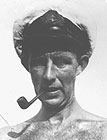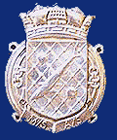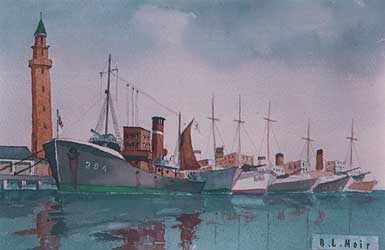


 |
 |
 |
|
With
The Wavy Navy (continued) When I arrived to report to the Captain who was an active "Barents Sea" Captain I was amazed how large were these deep sea trawlers. I learned that, in the late 1930's a good fishing skipper could earn about £20,000 a year - and that in those days was a great deal of money! I had always been a lover of the sea and thus I became determined to fight any war, that should materialise, as a seaman. I also learnt that some of the larger deep sea fishing firms built new trawlers to the suggested designs of their most successful skippers. Needless to say the skippers accommodation, in particular, was most luxurious. I understand these very successful skippers had an uncanny knack of knowing, by the colour of the sea and the smell of fish where these fishing grounds were situated - and they altered daily. Such
skippers kept complete radio silence to avoid being located and followed
by others! Some weeks were spent on H.M.T. Leicester City whilst she
was being converted and fitted with guns and depth charges - but not
any radar - this was then only available to big ships of the Royal Navy
!!
|
 HMT Hammond at Hull 1940 A requisitioned Deep Sea Trawler of the Cricket Class |
|
| My
next ship was H.M.T. Hammond, a trawler of the Cricket Class. When I joined
she had already been converted for anti submarine and minesweeping work
and was based at Hull/Grimsby
In those days there was a shortage of men to man these ships. On H.M.T. Hammond there was a skipper (Royal Naval Reserve) a 1st Lieutenant and myself. It was hard work at sea because it meant for the First Lieutenant and myself, four hours on watch, four hours off - over several days at sea that was quite tiring. Our allocated job was to escort coastal convoys ploughing between Southend and Aberdeen. The Southern part of this run was known as "E BOAT ALLEY". It was here that at nights German E boats would tie up to buoys which marked the swept channel, and wait for the convoy. Once the convoy was abeam of them they would fire off their torpedoes, slip from the buoys and steam off home at high speed. All this was at the beginning of 1940 when shipping losses were very high and morale low. But on 4th March all ships of the Fleet received the following signal "WINNIE IS BACK" from the Admiralty. That signal of few words lifted the morale of the Fleet beyond what anyone could have thought possible. I have press photo taken of a trawler escort on convoy duty which reads as follows: "Off on the danger patrol goes this small armed trawler. Leaving an East Coast Port at the break of dawn she carries out a job fraught with peril. It is these small boats - manned by reservists and peace time fishermen - who are the unsung heroes of the war. Their job is important - they keep your food supplies safe". H.M.T. Hammond former Grimsby Trawler, after gallantly resisting 3 days of bombing by Nazi aircraft, sank in Namsos Fjord Norway in the Summer of 1940. There is a saying that rats always leave a sinking ship. I must have been a 'Rat' because I was drafted to HMT Lord Lloyd only days before she was sunk. |
 |
 |